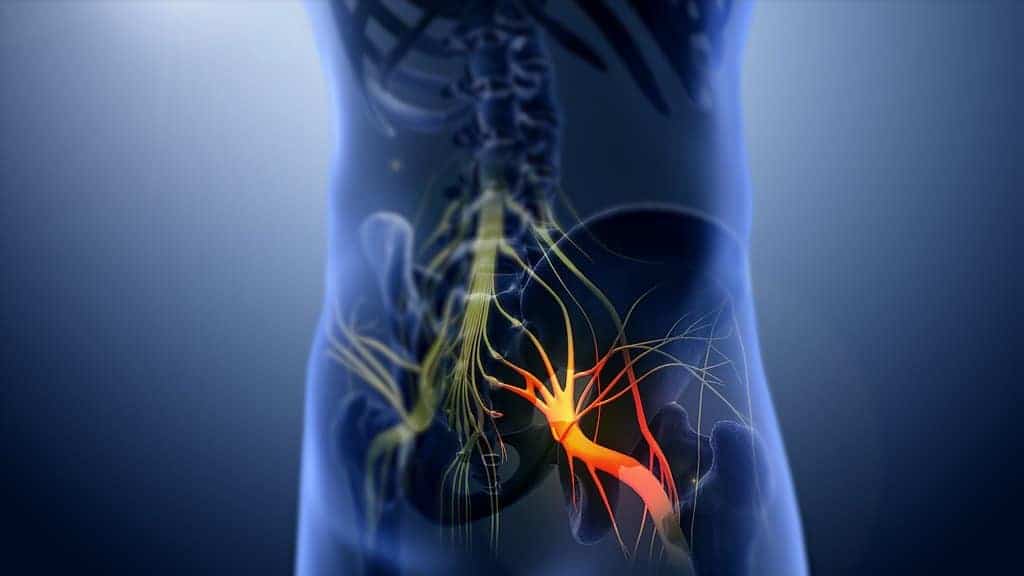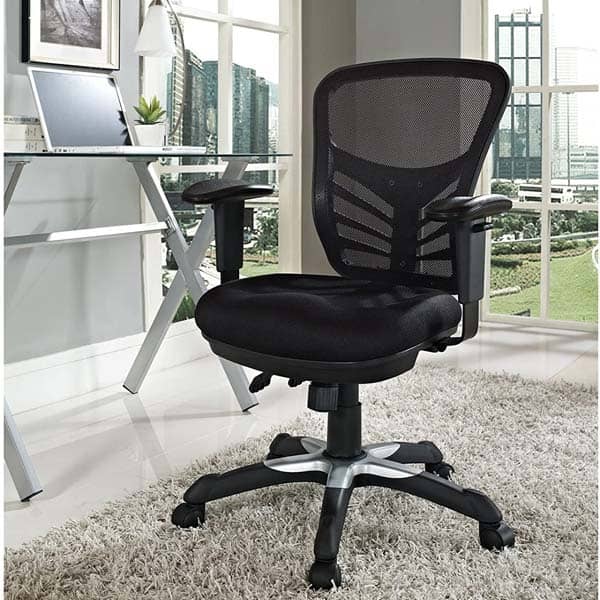Anyone who suffers from sciatica knows the nagging pain that comes from sitting for long periods at home, in the office or at your gaming chair.
It can make life miserable for the sufferer, and with your average office workplace demanding longer and longer hours clamped to ill-equipped swivel chairs, the amount of pain you’re in can increase tenfold.
Sciatica is incredibly debilitating for those who experience it – a sharp, shooting pain that originates in the lower spine and travels down the legs. It can leave people virtually paralyzed for weeks at a time.
Contrary to the received wisdom, sitting down does not alleviate this acute pain. In fact, it can make it a lot worse!
When a disc between the vertebrae loses its elasticity, it can bulge, herniate or even prolapse out at the side, pinching on the sciatic nerve while you’re sitting down. This transforms sitting, an activity that is generally considered relaxing, into an intolerable agony.
But is there a way to sit comfortably with sciatica? Which postures soothe and which ones aggravate our sciatica? How can I augment my chair in a way that will give me the maximum amount of support and comfort throughout my workday?
Well, we can’t claim to have all the answers, but we do have one or four. Below we’re going to discuss the medical origins of sciatica, what the best postures are and what other activities you can do on your breaks during the day to alleviate sciatic pain.
Interested in finding the best office chair for sciatica? Read this post.
Sciatica – The Painful Truth
A lot of people may suffer from sciatica without knowing it or seeking treatment. Most people dismiss sciatic pain as an old sports injury acting up or a sign of old age. Most people also don’t attribute it to a lifetime of poor posture or a badly-supported office chair.
The sciatic nerve is a lengthy one that twists through your lumbar region and into your thighs, right the way down into your legs. It is deeply interconnected with the discs in your spine and is very susceptible to impact trauma.

When the sciatic nerve becomes overstimulated by a bulging or herniated disc in the lower back, it can become severely inflamed, leading to pain that can vary from a light numbness to a throbbing in the lumbar region or stabbing pain that you can feel down to your toes.
Sciatica can be activated during more strange moments – during a sneezing fit, twisting at an awkward angle as you get out of bed, but one of the more common catalysts for sciatica is prolonged sitting.
Sitting And Sciatica
Most people are aware of the term ‘slipped disc’, called so because your hips or spine are misaligned, causing you to feel lopsided, like one of your discs has ‘slipped’ out. However, this is not quite what happens.
The discs in your back cushion the space between the bones in your spine and are more like spongy spheres than discs.
These spongy bits are full of water, making them hard enough to give support but also flexible enough to move with the shape of your body.
During the morning you might notice that you feel a little stiff in your spine – this is partly because your discs are dehydrated!
When the discs have less water, they go very flat and the space between the vertebrae is narrowed considerably. The inside of a disc is also softer and can spill out or ‘bulge’ through the outer layer from the inside.

Image Credit: Wikipedia
So if you sit down, that spongy disc is compressed further, causing it to bulge more and press harder on the sciatic nerve. This is the reason why sitting with sciatica causes so much pain.
There are many chronic illnesses and conditions that develop in the body after long hours of sitting, including muscle wastage, deep vein thrombosis and piriformis syndrome. But it is not always practical to get up and shake out those aches and pains during your workday.
However, help is at hand. Here are a few ways you can reduce your pain while sitting with sciatica.
The Power Of Chairs
Some of you might have already been researching a brand new office chair. If so, you will have come across the term ‘ergonomic’ over and over again. What does it mean?
An ergonomic chair is designed to give support to the posterior, that is, the lumbar region, the seat and the thighs. These chairs usually come with a unique S-shaped curve that molds to the shape of the spine and helps bear the weight of your torso.

When shopping for an ergonomic chair, you have to essentially tailor your chair to your specific needs.
If you have sciatica, you will need a very firm s-shaped backrest that won’t result in the vertebrae squeezing together. Ideally, the base of your backrest will push your belly outwards, making the spine straight and pushing the herniated disc back in.
If you’re a gamer, armrests are important for keeping the upper body straight, supporting your arms as they hold the controllers.
A hunched posture will result in more strain on your lower spine as it struggles to bear a forward-leaning torso load, again causing the disc in the back to bulge and press on the sciatic nerve.
A Few Tips For Good Posture
So, those are a few tips on buying a chair that will keep you supported for longer. But you can’t leave it all up to the chair. There are a number of posture-correcting exercises that will help relieve pain in that temperamental sciatic nerve.
Straight Spine, Flat Feet
Push your back as far as you can into the chair, making sure that the bottom of your back is in direct contact with the inside corner of the chair.
Make sure your feet are in contact with the floor, shoulder-width apart, and that your legs aren’t dangling. If you find that your legs are dangling, you might have a chair that is too large for your height. Dangling feet cause you to slouch and put more pressure on your spine and legs.
By sitting back in your chair, your posterior is completely supported, which will give the spine less to do.
Crossing Your Legs
Some people find that crossing their legs helps to stabilize their seating position and therefore their spine. You can certainly test this hypothesis, but make sure that you aren’t sitting lopsidedly, as this will cause the body to overcompensate and strain the back muscles in the side that’s doing all the work.
Make sure that your shoulders, hips and knees are more or less in a straight line.
Related: Find the best office chair to help with hip pain.
Foot And Knee Elevation
You might want to invest in a small stool if your feet don’t touch the ground. A lot of chiropractors would suggest that you have your knees lower to the floor. It all depends on comfort, so the hard and fast rule for posture is: if it causes you pain, change position.
DIY Lumbar Support
For the budget-conscious sciatica sufferer, the idea of spending the wages they earned sitting in a chair on lumbar support for that same chair is a laughable notion.
If you don’t want to spend thousands of dollars on your office chair, you can just grab a towel, a hoodie or a cylindrical piece of foam and wedge it in your lower back.
When your spine arches outwards, the bulging disc is pushed in, which releases the sciatic nerve from undue pressure. If you don’t have those materials at hand, a balled-up fist in the base of your spine every half an hour will also give you some relief.
Pressed, that is. A balled-up fist pressed into the base of your spine. We’re not advocating workplace violence.
Easing sciatic pain is not always a clear cut process. Every spine and injury is different, so there is a lot of trial and error involved. The general rule to stick by is that if it alleviates pain, then it’s doing the job.
Thinking Outside The Chair – Other Ways To Help Sciatica
Keep Calm And Carry On
There is a school of thought in the world of back pain that mental and physical health are intrinsically linked. Think about it – when you get stressed, you tense your muscles, whether you know it or not.
You may find that your sciatica worsens when you’re under pressure. Make a note every time you feel stressed and compare it with your sciatica flare-ups.
Also, do not interrupt your normal patterns of behavior. Try and avoid lying in a prone position with sciatica, as this will cause the muscles around the back to seize up, making the pain far worse.
The fluid in the discs is reabsorbed through movement, so getting up and walking around will help with disc elasticity. It will also loosen that pressurized sciatic nerve.
Buy A Heat Pack
Heat packs are great for back pain and can discreetly be applied to the sciatic area under your regular office wear. Your colleagues never need to know.
Cooling packs help reduce inflammation around the spine area too. You can get packs containing materials that will heat up in the microwave and freeze when placed in the freezer.